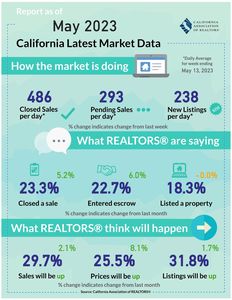Despite encouraging news on inflation dropping to the lowest level in nearly two years, both consumers and business owners continued to grow more pessimistic about the economic outlook. Debt ceiling, bank failures, recession fears, and persistent inflation remained some of the economic concerns that lowered the public sentiment. While the strength in the labor market has continued to support households’ finances and helped mortgage delinquencies to reach the second lowest level since 1979, high costs of borrowing and affordability constraints continued to hurt the overall homebuying sentiment.
 Home purchase sentiment improves as consumers’ optimism on mortgage rates amend: The Fannie Mae Home Purchase Sentiment Index® (HPSI) increased in April to its highest level since May 2022, jumping 5.5 points to 66.8. All six of the HPSI’s components increased month over month, including the one associated with consumers’ expectations on mortgage rates. While almost half of respondents still expected mortgages rates to rise over the next year, nearly a quarter (22%) of them expect mortgage rates to go down. With costs of borrowing remaining elevated and affordability constraints continuing to hurt overall homebuying sentiment, less than one in four (23%) respondents said that it is a good time to buy a home.
Home purchase sentiment improves as consumers’ optimism on mortgage rates amend: The Fannie Mae Home Purchase Sentiment Index® (HPSI) increased in April to its highest level since May 2022, jumping 5.5 points to 66.8. All six of the HPSI’s components increased month over month, including the one associated with consumers’ expectations on mortgage rates. While almost half of respondents still expected mortgages rates to rise over the next year, nearly a quarter (22%) of them expect mortgage rates to go down. With costs of borrowing remaining elevated and affordability constraints continuing to hurt overall homebuying sentiment, less than one in four (23%) respondents said that it is a good time to buy a home.
Mortgage delinquency rate declines in the first quarter of 2023: According to the Mortgage Bankers Association’s (MBA) National Delinquency Survey, the delinquency rate for mortgage loans on one-to-four-unit residential properties decreased to a seasonally adjusted rate of 3.56% of all loans outstanding at the end of Q1-2023. This was the lowest level for any Q1 since MBA’s survey began tracking delinquency rates in 1979 and the second all-time lowest, just 11 basis points (bps) above Q3-2022. The delinquency rate decreased 40 bps from Q4-2022 and 55 bps from one year ago. The year-over-year improvement was broad based across all product types – FHA, VA and conventional – and across all states. The performance of existing mortgages is exceeding expectations but is not a complete surprise as mortgage delinquencies typically track closely with unemployment, and the job market is currently displaying remarkable resiliency.
Consumer sentiment slumps in early May: The preliminary read of the Consumer Sentiment Index for May shows a decline in the index to 57.7, as consumers became bitter towards the economy as they reported less optimistic views on both current conditions and expectations for the future. As the index fell to the lowest level in six months, medium-to-long term inflation expectations also jumped to a 12-year high, which is an implication that consumers expected inflation to remain higher for longer. Consumers have displayed a remarkable resilience so far but growing uncertainty due to persistent inflation and a slowing economy continued to dampen their mood.
Small business optimism dips as labor challenges persist and economic outlook grows gloomier: According to the National Federation of Independent Business’s (NFIB) Small Business Optimism Index, business owners are becoming more pessimistic towards the economy. The index fell to 89 in April, the lowest reading in over a decade. While owners are growing less optimistic, fewer of them reported credit being harder to obtain despite recent banking turmoil. The report also offered some positive news on the inflation front. The share of business owners indicating raising prices declined for the fifth consecutive month, while the share of firms planning to raise prices, fell to the lowest level since November 2020. Fewer firms also reported raising compensation, suggesting an overall downshift in compensation as a result of improvements in the labor market. Nevertheless, firms reiterated that labor quality and the search for talent remained a challenge, which when combined with a gloomy economic outlook weighed on their overall optimism.
Consumer prices remain elevated but continue to ease gradually: The Consumer Price Index (CPI) increased 0.4% in April and 4.9% over the past 12 months. Excluding food and energy, the core CPI rose 0.4% in the month and 5.5% over the year. Shelter costs went up 7.5% over the last year and the corresponding index remained the largest contributor to the monthly all-items increase. Inflation is cooling in recent months despite the increases, but the improvement has been gradual. Softer readings for energy and food inflation, in fact, helped push year-over-year headline CPI inflation below 5% for the first time in two years. There are couple more inflation-related reports scheduled to be released before the next FOMC meeting, but the April CPI release offers some encouraging news that the Fed’s pause on rate hike could be on the horizon.



